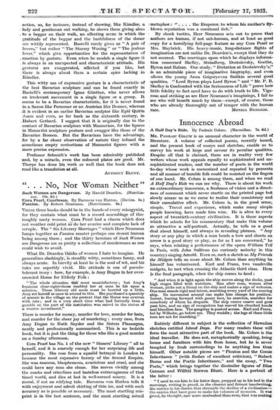Meissen or Nymphenburg ?
PROFESSOR SCII MIDT has written an admirably lucid history of the development of porcelain. He is primarily concerned with Europe, and the history of porcelain in the Far East is therefore summed up in about twenty pages. But in this brief account the author has wisely included just those filets which bear on the subsequent tendencies in European porcelain, and has included a section on the origin of the passion for chinoiseries in Europe. He also hints at the influence of this passion on architectural decoration and describes specimens of Rococo rooms made specially to house collections of Oriental vases.
Professor Schmidt divides the body of the book into two parts, one dealing with vessels, the other with figures. The pure layman may find the former section slightly technical, but, given a knowledge of the jargon, it makes pleasant enough reading and the narrative is clear and coherent. In order to suit his public the translator has added a chapter and many plates dealing with the English factories which, however, he does not attempt to defend from the charge of provincialism where compared with Sevres or Meissen.
By far the most fascinating part of the book deals with porcelain figures, parties la .ly the German. Here the author and the translator conic into conflict, for whereas Professor Schmidt has written his book with the emphasis on Kandler, the greatest modeller of Meissen, Mr. Thorpe explieitly takes as his hero Bustelli, the supreme artist of Nymphenburg. Ultimately preference in this matter will, of course, be a matter of taste, but the problem can be related to a more general question. For the difference between Kiindler and Bustelli is not merely a matter of porcelain ; it is funda- mentally the same as that between Saxon and Bavarian sculpture and modelling on any scale. Apart from technical questions Bustelli's figures differ from Kiindler's in the matter of gesture. The attitudes of Kiinrdler's figures are pleasant and natural, but they are conventional and inexpressive. His dandies stand elegantly ; their hands make an easy movement, but the figures do not convey any particular meaning. His lovers behave with decorum, but without passion. In Bustelli's figures, on the other hand, every gesture is relevant. He shows a preference for scenes representing a definite
action, so, for instance, instead of showing, like Kindler., a lady and gentleman out walking, he shows them giving alms . to a beggar on their walk, an affecting scene in which the gratitude of the beggar and the bashfulness of the donor are wittily represented. Bustelli rarely gives us "A pair of lovers," but rather "-The Stormy Wooing" or "The jealous lover," which give opportunities for the representation of . emotion by gesture. Even when he models a single figure it is always in an unexpected and characteristic attitude. His . gestures are exaggerated, affected if you like, but there is always about them a eertain spice lacking in Handler.
'This witty use of expressive gesture is a characteristic of the best Bavarian sculpture and TIM be found exactly in Bustelli's contemporary Ignaz Gunther, who never allows • an irrelevant movement in a single figure or a group. It seems to be a Bavarian characteristic, for it is never found in a Saxon like Permoser or an Austrian like Donner, whereas . it is evident in an earlier Bavarian sculptor like Egid Quinn Asam and even, as far back as the sixteenth century, in . Hubert Gerhard. I suggest that it is originally due to the .contact of Bavarian sculptors with Mannerism, for the figures in Mannerist sculpture posture and swagger like those of the ,Bavarian Rococo. But the Bavarians have the advantage, for by a far closer observation of nature they infused the sometimes empty contortions of Mannerist figures with a more precise expression.
Professor Schmidt's work has been admirably published -and, by a miracle, even the coloured plates are good. Mr. Thorpe has done his work so well that the book does not read like a translation at all,
ANTILDNY BLUNT.







































 Previous page
Previous page